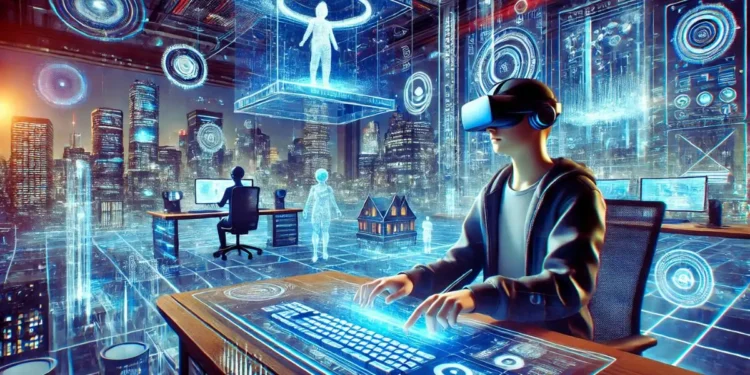Imagine putting on a VR headset and stepping into a metaverse workplace where your colleagues—scattered across the globe—greet you as lifelike avatars. Meetings happen in a 3D immersive environment, virtual whiteboards float in mid-air, and your office is a customizable digital space. Sounds like science fiction? It’s closer than you think.
Are you ready to step into a world where your office is no longer confined to four walls? The concept of working in the metaverse has been gaining momentum, and it’s not just a futuristic dream anymore. But what exactly does this mean for us as workers, employers, and innovators? In this article, we’ll explore what distinguishes the metaverse from traditional online platforms, how metaverse technology is shaping the future of work, and whether virtual jobs are here to stay—or if they’re simply hype.
The metaverse is no longer just a buzzword from TIME magazine metaverse articles—it’s evolving into a tangible workspace. But what distinguishes the metaverse from traditional online platforms? And more importantly, is working in the metaverse the next big career shift, or just another tech hype?
In this guide, we’ll explore:
How the metaverse works and the technology enabling immersive 3D environments
The rise of virtual reality jobs, including entry-level VR jobs and remote XR developer roles
The impact of biometric systems in managing employees
Whether Meta Quest jobs and AR/VR developer jobs are here to stay
The challenges and opportunities of working in the metaverse
By the end, you’ll have a clear picture of whether the metaverse is the future—or just a fleeting trend.
What Is the Metaverse in Simple Words?
Before diving into metaverse technology, let’s break it down. The metaverse is a collective virtual space where users interact via avatars, digital assets, and immersive 3D environments. Unlike traditional video calls or Slack chats, the metaverse blends virtual reality (VR), augmented reality (AR), and blockchain to create persistent, interactive worlds.
How Do Users Typically Interact with the Metaverse?
VR Headsets (Oculus Quest, HTC Vive) for full immersion
AR Smart Glasses (Microsoft HoloLens) for mixed-reality workspaces
Desktop/Mobile Access for browser-based metaverse platforms
Think of it as the next evolution of the internet—a place where work, socializing, and commerce happen in a shared digital universe.
The Metaverse Workplace: How It’s Changing Remote Jobs
Remote work exploded post-pandemic, but Zoom fatigue and isolation remain challenges. Could the metaverse workplace be the solution?
1. Enhanced Collaboration in Virtual Offices
Companies like Accenture have already built virtual campuses where employees meet as avatars. What technology enables this? Tools like Unity and Unreal Engine power 3D environments, while spatial audio makes conversations feel natural.
“The metaverse bridges the gap between physical and remote work, making collaboration more engaging.” — Harvard Business Review
2. Virtual Training & Simulations
Surgeons practice operations in VR before real procedures.
Walmart uses VR employee training to simulate Black Friday crowds.
This isn’t just gaming—it’s how the metaverse works to upskill workers safely.
3. Personalized Digital Workspaces
Forget dull cubicles. In the metaverse, your office could be a beach, a spaceship, or a Zen garden. Companies like NextMeet offer avatar-based platforms where teams brainstorm in interactive 3D spaces.
New Careers in the Metaverse: Are Virtual Jobs the Next Gold Rush?
With VR jobs remote opportunities rising, let’s explore the hottest roles:
1. Entry-Level VR Jobs
3D Modelers – Design virtual assets for metaverse worlds.
Virtual Event Managers – Organize concerts, conferences, and expos in immersive environments.
2. High-Paying Tech Roles
XR Developer Jobs (Remote) – Average salary: $120,000+ (Glassdoor).
AR/VR Developer Jobs (Remote) – Building apps for Meta Quest and other platforms.
3. The Rise of Digital Real Estate
Just like physical property, virtual land in Decentraland and Sandbox is selling for millions. Could you be the next metaverse real estate mogul?
Challenges of Working in the Metaverse
While the opportunities are exciting, there are hurdles:
1. Digital Fatigue & Isolation
Staring at a VR headset for 8 hours can cause eye strain and motion sickness. Will employees trade Zoom burnout for metaverse fatigue?
2. Privacy & Biometric Systems
Some companies use biometric tracking to monitor employee engagement in virtual offices. Is this innovative—or invasive?
3. Accessibility & Cost
Not everyone can afford a $1,000 VR headset. Will the metaverse deepen the digital divide?
Is the Metaverse the Future of Work?
Imagine attending meetings as a 3D avatar, collaborating with colleagues across continents in immersive environments, or even designing entire buildings without leaving your home. This isn’t science fiction—it’s happening now. According to TIME Magazine, the metaverse could revolutionize industries by enhancing remote work practices and creating entirely new opportunities.
But before we dive deeper, let’s answer a fundamental question: What is the metaverse in simple words?
At its core, the metaverse refers to a collective virtual space that combines augmented reality (AR), virtual reality (VR), and mixed reality (XR) technologies to create interactive digital worlds. These spaces allow users to interact through avatars, participate in events, and perform tasks much like they would in the physical world. So, how do users typically interact with the metaverse? Through devices like VR headsets, AR glasses, or even smartphones, people can engage in everything from gaming to professional collaboration.
But here’s the million-dollar question: Will the metaverse workplace replace our traditional offices? Or will it complement them? Let’s break it down.
How Does the Metaverse Enhance Remote Work?
1. Immersive Collaboration and Communication
One of the most exciting aspects of how metaverse works is its ability to transform collaboration. Traditional video calls often lack the personal touch needed for effective teamwork. However, the metaverse bridges this gap by allowing users to meet in 3D spaces. For instance, platforms like NextMeet offer avatar-based solutions that mimic real-world interactions, making remote teams feel more connected.
- Key Benefit: Non-verbal cues such as gestures and facial expressions become visible again, improving communication.
- Example: Imagine brainstorming ideas while walking through a virtual whiteboard room—sounds pretty cool, right?
2. Revolutionizing Training and Learning
Companies are already leveraging metaverse technology to provide hands-on training experiences. Whether it’s teaching auto mechanics via VR simulations or practicing industrial safety protocols, these tools reduce risks associated with real-world practice.
Not only does this enhance skill acquisition, but it also makes learning more engaging.
So, what technology enables the creation of immersive 3D environments within the metaverse? Advanced graphics processing units (GPUs), AI-driven algorithms, and cloud computing all play critical roles in bringing these virtual worlds to life.
What New Opportunities Does the Metaverse Create?
1. Entry-Level VR Jobs and Beyond
As the demand for virtual reality jobs grows, so do career opportunities. From Meta Quest jobs to XR Developer jobs remote , there’s something for everyone. Salaries vary depending on expertise, but roles like AR/VR developers and content creators are booming. According to Verizon, industries such as real estate, design, and marketing are ripe for innovation within the metaverse.
- Question for Readers: Have you considered exploring entry-level VR jobs ? With salaries ranging from 150k annually, it might be worth looking into!
2. Personalized Virtual Workspaces
Another game-changer is the ability to customize your workspace. Employees can tailor their virtual environments to suit their preferences, boosting both productivity and satisfaction. Accenture’s virtual campus serves as an excellent example of how personalized spaces can enhance employee well-being.
Challenges and Considerations: Is It All Sunshine and Rainbows?
While the benefits of working in the metaverse are undeniable, there are challenges to consider:
1. Technical Hurdles
Despite advancements, issues like cybersickness and ergonomic discomfort persist. Additionally, not everyone has access to high-end VR equipment, which raises accessibility concerns.
2. Security and Privacy
With increased reliance on biometric systems for managing employees, ensuring data protection becomes paramount. As companies integrate metaverse technology , safeguarding sensitive information must remain a top priority.
3. Balancing Physical vs. Virtual Interaction
Although the metaverse offers incredible flexibility, some argue that nothing beats face-to-face interaction when fostering creativity and innovation. “Watercooler moments” may still hold value in sparking groundbreaking ideas.
FAQs: Your Burning Questions Answered
Can you get a real job in the metaverse?
Absolutely! From Meta Quest jobs to virtual reality jobs salary roles, companies are hiring for metaverse-related positions.
Is the metaverse a good career path?
With tech giants like Meta, Microsoft, and NVIDIA investing billions, XR developer jobs and AR/VR roles are booming.
How does the metaverse affect employment?
It’s creating new industries (virtual fashion, digital real estate) while transforming traditional jobs (remote work, training).
What is the metaverse industry forecast?
Experts predict the metaverse could be a $800 billion market by 2024 (Bloomberg).
Why will the metaverse change the way you work?
It merges physical and digital workspaces, enabling global teams to collaborate like never before.
What is the future of work in the metaverse?
Experts predict that the metaverse will enhance current remote work models, offering immersive collaboration tools and new job opportunities. However, it won’t fully replace traditional workplaces.
Can you get a real job in the metaverse?
Absolutely! Roles like AR/VR Developer jobs remote Meta Quest jobs, and other tech-driven positions are becoming increasingly common.
What is the future of VR in the workplace?
From training simulations to virtual meetings, VR jobs remote are expected to skyrocket as businesses adopt metaverse technology.
How does metaverse affect employment?
It creates new roles while transforming existing ones. Think virtual event planners, 3D designers, and more.
What does working in the metaverse mean?
It means performing tasks in virtual environments using avatars and advanced technologies like VR and AR.
What is the future of AI in metaverse?
AI will likely power many aspects of the metaverse, including personalized experiences and intelligent assistants.
How could the metaverse change work?
By enabling global collaboration, reducing travel costs, and providing safer training environments.
Conclusion: The Metaverse Is Coming—Are You Ready?
The future of work in the metaverse isn’t just about VR headsets and 3D avatars—it’s about redefining how we connect, create, and collaborate.
Will it replace offices entirely? Probably not. But for remote teams, virtual training, and digital-first careers, the metaverse offers groundbreaking possibilities.











































